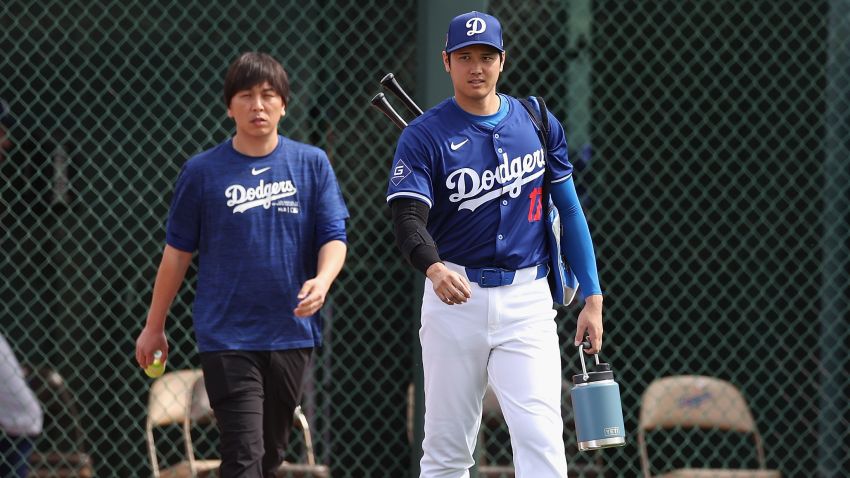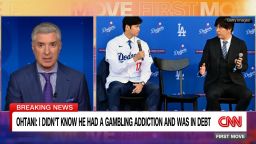Editor’s Note: Keith O’Brien is the author of the new book “Charlie Hustle: The Rise and Fall of Pete Rose, and the Last Glory Days of Baseball.” The views expressed in this commentary are his own. View more opinion on CNN.
We’re a week into baseball’s gambling crisis surrounding Los Angeles Dodgers two-way superstar Shohei Ohtani, his close friend and former interpreter Ippei Mizuhara, an alleged illegal bookmaker in southern California and at least $4.5 million in wire transfers from Ohtani’s bank accounts. And already, Ohtani, Mizuhara, their representatives, and Major League Baseball (MLB) have changed their stories or positions—so many times that it’s hard to keep up.
Like a nasty breaking ball, this narrative, on the eve of Opening Day, has dipped and moved out of the strike zone and skittered away to the backstop.

In the latest development, Ohtani broke his silence late Monday and told reporters that he had “never bet on baseball or any other sports” and denied ever asking anyone “to do it on my behalf.” At the press conference, a new interpreter sat at his side. He took no questions and in his final remarks seemed to try to turn the page. “I’m looking forward to focusing on the season,” Ohtani said. “I’m glad we had this opportunity to talk.”
It is, without question, just the beginning. Ohtani’s attorneys have not provided any details on how they believe the funds were stolen from the superstar’s bank accounts, which has only fueled questions about the scandal as Ohtani is set to make his much-anticipated debut with the Dodgers on Thursday after signing a 10-year $700 million contract late last year.
Last Friday, MLB announced it had opened a “formal process investigating the matter.” Federal investigators are still building their case against the alleged bookie and legions of reporters — on two continents — are just starting to dig into the murky details surrounding the Japanese star’s bank account. But it’s worth pointing out that there is a model for what comes next. MLB knows how to do this. It’s been here before.
In the earliest days of baseball’s last gambling crisis — the Pete Rose gambling scandal 35 years ago, in 1989 — the men in charge knew exactly how they wanted to handle the problem of Rose’s alleged gambling. For starters, they got ahead of the story.
In February 1989, about four weeks before Sports Illustrated wrote a series of articles detailing Rose’s bets on baseball and his own team, the Cincinnati Reds, top officials in baseball’s front office invited Rose to come to New York City for a secret meeting to discuss rumors of his gambling.
In attendance that day, aside from Rose and his lawyers, were outgoing baseball commissioner Peter Ueberroth, incoming commissioner Bart Giamatti, and Giamatti’s hand-picked deputy and close friend, Fay Vincent. And based on interviews I did for my new book “Charlie Hustle,” the meeting was both friendly — and filled with lies. When the baseball officials asked Rose if he had ever bet on baseball, he denied it.
“I’m not that stupid,” Vincent recalled him saying.
It could have ended right there. As Rose left that day, smiles and handshakes all around, both Giamatti and Vincent found Rose believable, in part because Rose was right: He couldn’t be that stupid.
MLB Rule 21, enacted in 1927, clearly states that players, managers, umpires or club or league officials face suspension for betting on games in which they’re not connected and for placing bets on an illegal bookmaking business. As for betting on games in which they have a role, they face permanent banishment.
Rose knew these rules; everyone knew these rules. And when news of the secret meeting leaked to the New York Times the following day, Ueberroth chose to downplay it. “There’s nothing ominous,” he said, “and there won’t be any follow-through.”
But even as he spoke these words, the men who had met with Rose were working on several possible “follow-throughs.” And Fay Vincent knew his preference. With Sports Illustrated circling — and the integrity of the game at stake — Vincent believed they couldn’t take Rose at his word. They had to conduct their own investigation and he thought he knew the right man for the job. His name was John Dowd. He was a longtime US Department of Justice attorney who had untangled lies before in difficult cases involving corrupt politicians and mobsters.
Within three days of the secret meeting with Rose in New York, commissioner Giamatti was on the phone with Dowd. Within 24 hours of that phone call, Dowd was on a plane to Cincinnati to interview his first witness — a man who had intimate knowledge of Rose’s gambling.
Dowd landed in Cincinnati that morning, imbued with the power of the commissioner; the Cincinnati Reds and others in baseball would have to cooperate with him. And by the end of the spring, Dowd would file a voluminous report, including nine volumes of exhibits and roughly 3,000 pages of documentation, that led to Rose’s permanent banishment from the game. And that changed baseball forever.
If that is the roadmap for success, then baseball officials today have already made a few wrong turns. The entire baseball world was seemingly caught off guard last Wednesday when news broke of the payments to the alleged bookie in California and the alleged connections to Ohtani, baseball’s biggest star.
Baseball lost the news cycle for at least the next 36 hours, chasing a story that quickly spun out of control, as Mizuhara recanted his original statement about what had happened and Ohtani’s representatives accused Mizuhara of “massive theft.”
In the meantime, Dodgers manager Dave Roberts, preparing for an international game in South Korea, had to sit before the press and cover his mouth as reporters asked questions about what the team knew and when. “I can’t comment on it,” Roberts said last week. “Can’t comment… Again, can’t say anything.”
Roberts wanted the reporters to know that the Dodgers were there “to play baseball.” But the baseball reporters now wanted to talk about gambling, and it wasn’t until Friday, two days after the original news story, that Major League Baseball announced that it had opened its inquiry into the situation.
What happens next isn’t clear. Since the Dodgers have fired Mizuhara shortly after ESPN and the Los Angeles Times broke the news, he would no longer be obligated to speak to whomever will be asking the questions in baseball’s Department of Investigations.
Ohtani could also decline to speak to investigators, invoking his right as a member of the MLB Players Association, the labor union representing all current players. And this inquiry will be taking place in a world radically different than the one John Dowd lived in 35 years ago.
Sports gambling is still illegal in California and players can still face suspension or banishment for gambling and betting on the game. But it’s now legal in 38 states to place wagers on a game.
Americans legally wagered a record almost $120 billion on sports last year, according to the American Gaming Association, and MLB has lucrative partnerships with legal gambling platforms. Indeed, baseball is often begging us to lay down a bet — on this game, on this pitch, on this at bat, right now.
In this new world — where seemingly everyone is betting and we are often doing it from the comfort of our couches, on our phones — do fans have the stomach for a lengthy gambling investigation into their favorite player? More importantly, does baseball?
It was hard enough 35 years ago when Giamatti, Vincent and Dowd put their careers on the line to pursue Rose and then banished him forever for his sins.
“I will be told that I’m an idealist,” Giamatti said in 1989. “I hope so.”
We might be about to find out how many idealists are left.





